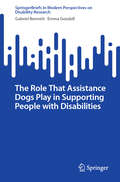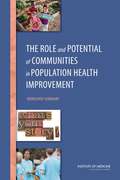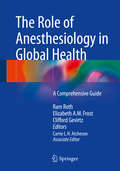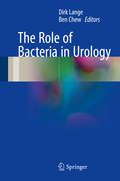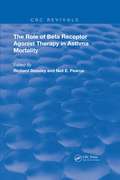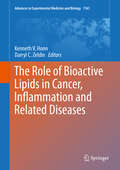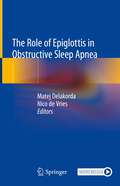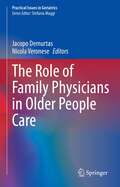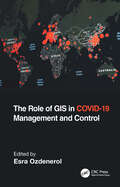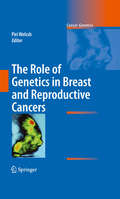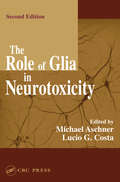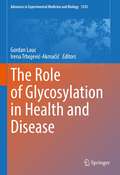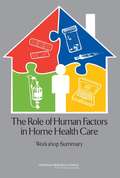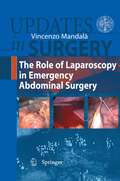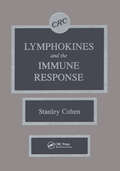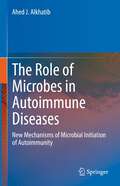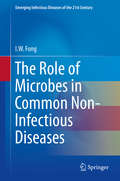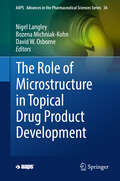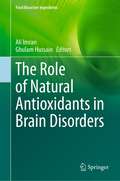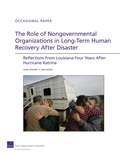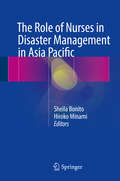- Table View
- List View
The Role That Assistance Dogs Play in Supporting People with Disabilities (SpringerBriefs in Modern Perspectives on Disability Research)
by Emma Goodall Gabriel BennettDogs have long been recognised as valuable companions for people with disabilities. In this book, readers will learn about how dogs can improve the quality of life for people with physical, sensory, and mental disabilities. Using participant and expert insights, this book explores the benefits of dogs, including how they can increase independence, improve emotional wellbeing, and enhance social connections. Whether you are a person with a disability, a caregiver, a healthcare professional, or simply interested in learning more about the remarkable ways in which dogs can support people with disabilities, this book offers a compelling and informative read
The Role and Potential of Communities in Population Health Improvement: Workshop Summary
by Theresa Wizemann"The Role and Potential of Communuties in Population Health Improvement" is the summary of a workshop held by the Institute of Medicine Roundtable on Population Health Improvement in April 2014 that featured invited speakers from community groups that have taken steps to improve the health of their communities. Speakers from communities across the United States discussed the potential roles of communities for improving population health. The workshop focused on youth organizing, community organizing or other types of community participation, and partnerships between community and institutional actors. This report explores the roles and potential of the community as leaders, partners, and facilitators in transforming the social and environmental conditions that shape health and well-being at the local level.
The Role of Anesthesiology in Global Health
by Elizabeth A.M. Frost Ram Roth Clifford Gevirtz Carrie L.H. Atcheson"This brilliantly assembled expert compendium provides a much-needed guide for the practical application of anesthesiology in medical practice in the most bereft underdeveloped and violence-afflicted regions of the globe. " --Seymour Topping, Professor Emeritus of International Journalism, Columbia University This is a comprehensive guide to the role of anesthesiologists in medical missions. In their capacity as perioperative physicians, anesthesiologists improve the safety and efficacy of surgical interventions for underserved patients in low- and middle-income countries around the world. Contributions from international experts in global health provide essential historical context, practical medical and surgical considerations for planning missions, and scenarios of "on the ground" implementation of care. The final section considers anesthesiology education in the context of global health. This is an encompassing and eye-opening resource for trainees and physicians considering participating in a medical mission and students and faculty of global health.
The Role of Antioxidants in Longevity and Age-Related Diseases
by Bee Ling Tan Mohd Esa NorhaizanThe average life expectancy has increased worldwide in the recent decades. This has presented new challenges as old age brings the onset of diseases such as cancer, neurodegenerative disorders, cardiovascular disease, type 2 diabetes, arthritis, osteoporosis, stroke, and Alzheimer’s disease. Studies and research have shown the potential preventive and therapeutic roles of antioxidants in aging and age-related diseases by inhibiting the formation or disrupting the propagation of free radicals and thus increasing healthy longevity, enhancing immune function, and decreasing oxidative stress. This has made an antioxidant rich diet of increasing importance in battling the detrimental effects of the aging process.“The Role of Antioxidants in Longevity and Age-Related Diseases” is the book that compiles research on antioxidants and their biological mechanisms that mediate age-related diseases. This book covers the major issues linked to antioxidants, aging, and age-related diseases, including changes in organ systems over the lifespan, age-related oxidative stress-induced redox imbalance, inflammaging, implications of inflammation in aging and age-related diseases, and the important role of antioxidant-rich foods in their prevention and treatment of various age-related diseases. For researchers seeking a comprehensive single source on antioxidants and their roles in aging and age-related diseases, this novel text provides an up-to-date overview.
The Role of Bacteria in Urology
by Dirk Lange Ben ChewThe aim of this book is to educate clinicians and basic scientists in the multiple roles that bacteria have as causative as well as therapeutic agents in urologic disease. Within this scope, clinicians will be introduced and educated about the basic mechanisms of bacterial pathogenesis that lead to disease, as well as the non-pathogenic mechanisms that contribute to the prevention and treatment of patients. Conversely, basic scientists will be educated about the clinical implications of bacterial based therapeutics and infections. By combining the basic science and clinical views, this book will serve to bring both basic scientists and clinicians onto an even plain that may raise ideas for future collaborative research.
The Role of Bacteria in Urology
by Dirk Lange Kymora B. ScotlandThis updated volume provides a concise guide to the pathogenic, therapeutic, and preventative roles of bacteria in urology. New chapters discussing the involvement of the microbiome in the areas of recurrent kidney stone disease, female urology, and prostate cancer are included. The treatment of urosepsis, stone management, genitourinary malignancy, stone sequencing, and the role of microbiome and virome in urology are also covered. The Role of Bacteria in Urology is relevant to both clinicians and scientists interested in the infection of the genitourinary system.
The Role of Beta Receptor Agonist Therapy in Asthma Mortality (Routledge Revivals)
by Richard Beasley Neil E. PearceFirst published in 1993, the Role of Beta Receptor Agonist Therapy in Asthma Mortality provides the first comprehensive review of the role of beta-receptor agonist drug therapy and asthma mortality. The book includes sections on the epidemiological and experimental methods used to examine possible relationships between beta-agonist drug therapy and asthma mortality. It also reviews the development of beta-agonist drugs and the long-term trends in asthma mortality to present a historical perspective. Internationally respected experts have contributed to this unique volume, making it essential for epidemiologists, pharmacologists, and researchers in clinical medicine and public health.
The Role of Bioactive Lipids in Cancer, Inflammation and Related Diseases (Advances in Experimental Medicine and Biology #1161)
by Kenneth V. Honn Darryl C. ZeldinThe Organizing Committee of the 15th International Conference on Bioactive Lipids in Cancer, Inflammation and Related Diseases compiled a group of junior investigators to provide reviews on the topics they presented at the Puerto Vallarta Bioactive Lipids conference, as part of the book series, Advances in Experimental Medicine and Biology (AEMB). The book in this series will be titled Bioactive Lipids in Cancer, Inflammation and Related Diseases. Topics range from all classes of lipids including prostaglandins, resolvins, spingolipids, P450-derived lipids, endocannabanoids and phospholipids. The focus includes physiology, cell biology, and structural studies in organisms from bacteria to humans and how these studies addressed the role of lipids in various disease i.e. cancer, inflammation, diabetes, obesity, cardiovascular disease and others.
The Role of Clinical Studies for Pets with Naturally Occurring Tumors in Translational Cancer Research: Workshop Summary
by Sharyl J. NassTraditional preclinical mouse models of cancer have been very useful for studying the biology of cancer, however they often lack key characteristics of human cancers. As a result, many novel drug candidates fail in human clinical trials despite evidence of drug efficacy in those preclinical models. Thus, researchers are seeking new approaches to augment preclinical knowledge before undertaking clinical trials for human patients. Recently, there has been renewed interest in comparative oncology - the study of naturally developing cancers in animals as models for human disease - as one way to improve cancer drug development and reduce attrition of investigational agents. Tumors that spontaneously develop in pet dogs and other companion animals as a result of normal aging share many characteristics with human cancers, such as histological appearance, tumor genetics, biological behavior, molecular targets, and therapeutic response. In June 2015 the Institute of Medicine hosted a workshop to examine the rationale and potential for integrating clinical trials for pet patients with naturally occurring cancers into translational cancer research and development. Participants discussed the research needs, strategies, and resources to support greater integration of clinical trials for pets with cancer into translational research pathways, and challenges and potential solutions for facilitating that integration. This report summarizes the presentations and discussions from the workshop.
The Role of Epiglottis in Obstructive Sleep Apnea
by Nico De Vries Matej DelakordaThis book provides a unique, detailed, and cutting-edge guide to obstructive sleep apnea (OSA) and the epiglottis. It discusses in detail epiglottis collapse both as relevant for diagnosis (e.g., sleep studies, drug induced sleep endoscopy, imaging and sound analysis) and treatment of OSA.In addition to general information on OSA, the chapters explore the role of the epiglottis in evolution, swallowing function, pathophysiology and surgical anatomy. The central chapters deal with patient selection, diagnosis, indications, and contraindications. The last sections investigate non-surgical treatments, surgical techniques, their results, possible failures, and complications. A conclusive chapter discusses research and future perspectives. The volume offers a large number of high-quality photos and illustrations, and an extensive collection of educational videos that highlight all steps of the surgical procedures. The book will appeal to all caregivers working in the field of diagnosis and treatment of obstructive sleep apnea, in particular otolaryngologists, pulmonologists, neurologists, sleep doctors, maxillofacial surgeons, anesthetists, and also the personnel working in sleep labs, general nurses and scrub nurses, physician assistants, and sleep technicians.
The Role of Family Physicians in Older People Care (Practical Issues in Geriatrics)
by Nicola Veronese Jacopo DemurtasThis book provides family doctors with a wealth of evidence-based indications and tips regarding geriatric medicine and approaches for the management of older patients, to be applied in daily practice. After discussing old and new features of healthy ageing and the approaches required in Family Medicine Consultation, the text introduces key elements of geriatric medicine such as frailty, sarcopenia, and the comprehensive geriatric assessment (CGA), before describing a range of characteristics unique to older patients in different contexts, with a dedicated section on Palliative Care. The role of polypharmacy and the importance of quaternary prevention and deprescribing are also addressed. Finally, the book emphasizes both the importance of a humanistic approach in caring and the approach of research and meta-research in geriatrics. Though many texts explore the role of primary care professionals in geriatric medicine, the role of family doctors in older people care has not yet been clearly addressed, despite the growing burden of ageing, which has been dubbed the “silver tsunami.” Family physicians care for individuals in the context of their family, community, and culture, respecting the autonomy of their patients. In negotiating management plans with their patients, family doctors integrate physical, psychological, social, cultural and existential factors, utilizing the knowledge and trust engendered by repeated visits. They do so by promoting health, preventing disease, providing cures, care, or palliation and promoting patient empowerment and self-management.This will likely become all the more important, since we are witnessing a global demographic shift and family doctors will be responsible for and involved in caring for a growing population of older patients. This book is intended for family medicine trainees and professionals, but can also be a useful tool for geriatricians, helping them to better understand some features of primary care and to more fruitfully interact with family doctors.
The Role of GIS in COVID-19 Management and Control
by Esra OzdenerolGeographic Information System (GIS) is one of the most important tools to help us understand public health and many aspects of our lives. Because of COVID-19, GIS has been brought into the spotlight more than ever before. People and civic leaders worldwide are turning to maps and real-time surveillance data to make sense of what has been happening in the world and to get answers to important questions on every aspect of this pandemic. This book examines the role of GIS in managing and controlling the spread of COVID-19 through 12 global projects and a multidisciplinary approach. It explains the innovative uses of GIS not only limited to data organization and data access, but also how improved GIS tools are used to make decisions, plan, and communicate various measures of control in both local and full-scale outbreaks during the COVID-19 pandemic. Features: Provides cutting-edge GIS visualization, spatial temporal pattern, and hot spot tracking applications used for predictive modeling of COVID-19. Includes real-world case studies with broad geographic scope that reflect COVID-19 trends in cases, deaths, and vaccinations. Provides lifestyle segmentation analysis on the risk of transmission of COVID-19 and spatial patterns of vaccination hesitancy. Highlights real-world issues brought to light with the help of GIS, such as social discrimination, inequalities in women’s access to mental health care, and analyzes the risk of transmission due to vaccination hesitancy. Shows the use of GIS and spatial analysis in pandemic mapping, management, and control from masking and social distancing to testing site locations accounting for at-risk and vulnerable populations. Discusses facilitating policy making with GIS. Edited by a very talented medical geographer and GIS Professor Dr. Esra Ozdenerol, this book highlights key GIS capabilities and lessons learned during the COVID-19 response that can help communities prepare for the next crisis. It is a great resource for industry professionals and experts in health care, public health and safety, disaster management, and for students, academics, and researchers interested in applying GIS and spatial analysis to the study of COVID-19 and other pandemics.
The Role of Genetics in Breast and Reproductive Cancers
by Piri WelcshThis volume will explore the latest findings in research into the genetics of breast and reproductive cancers, covering the epidemiological aspects of these cancers, their etiology, the effect of environment on genes and cancer etiology, and how research in this area can lead to development of preventative measures and treatments.
The Role of Glia in Neurotoxicity
by Michael Aschner Lucio G. CostaPresenting the latest research in glial cell function gleaned from new techniques in imaging and molecular biology, The Role of Glia in Neurotoxicity, Second Edition covers multiple aspects of glial cells, including morphology, physiology, pharmacology, biochemistry, pathology, and their involvement in the pathophysiology of neurological diseases.
The Role of Glycosylation in Health and Disease (Advances in Experimental Medicine and Biology #1325)
by Gordan Lauc Irena Trbojević-AkmačićGlycobiology is an emerging field of studying glycans (sugars) and glycoconjugates that are essentially involved in almost all biological processes, from fine-tuning glycoprotein function to protein-protein interactions, signaling, immune response, host-pathogen interactions, etc. However, due to structural complexity of glycans and analytical challenges this exciting field was lagging behind other areas of biology. With technological advancements growing number of glycans’ functions are being discovered and the study of glycans is becoming a cutting-edge discipline in basic and clinical research.Despite recent developments in glycobiology field, many aspects of glycosylation process still remain unknown, both in a healthy human organism and in pathological states. Human glycome is dynamic and changes with physiological triggers, immune challenges and disease. Atypical glycosylation is consequently a subject of disease biomarker research, and a target for therapeutic interventions. On the other hand, properties of glycosylated biotherapeutics are predominantly determined by their glycans.The Role of Glycosylation in Health and Disease provides a comprehensive overview of types and functions of glycans in a healthy human organism as well as their role in pathophysiology of different diseases and efficiency of glycosylated biotherapeutics. Written by the experts in the field, this book aims to bring glycobiology field closer to students, researchers in life sciences and professionals in biopharmaceutical industry.
The Role of Human Factors in Home Health Care: Workshop Summary
by National Research Council of the National AcademiesThe rapid growth of home health care has raised many unsolved issues and will have consequences that are far too broad for any one group to analyze in their entirety. Yet a major influence on the safety, quality, and effectiveness of home health care will be the set of issues encompassed by the field of human factors research--the discipline of applying what is known about human capabilities and limitations to the design of products, processes, systems, and work environments. To address these challenges, the National Research Council began a multidisciplinary study to examine a diverse range of behavioral and human factors issues resulting from the increasing migration of medical devices, technologies, and care practices into the home. Its goal is to lay the groundwork for a thorough integration of human factors research with the design and implementation of home health care devices, technologies, and practices. On October 1 and 2, 2009, a group of human factors and other experts met to consider a diverse range of behavioral and human factors issues associated with the increasing migration of medical devices, technologies, and care practices into the home. This book is a summary of that workshop, representing the culmination of the first phase of the study.
The Role of Laparoscopy in Emergency Abdominal Surgery
by Vincenzo MandalaThis is the first time a book about laparoscopy in emergency abdominal surgery has been published. Numerous articles have been published in specific surgical journals, but, until now, there has not been a book that collates all the aspects of this little-known field. The aim of this volume is to achieve a complete and easy presentation of all the implications associated with laparoscopy in emergency abdominal surgery. The book should be a manual that can be easily consulted by digestive, general, and specialized surgeons, especially in an emergency. The authors' contributions are founded on evidence-based medicine, which give the book scientific credibility, but this is coupled with their experience of daily practice, which adds an important complementary dimension to evidence-based medicine. This is balanced by an emphasis on clarity and accessibility, because the ultimate aim of the book is educational. We hope this book will be frequently consulted, in depth, not only by specialist practitioners, but also by undergraduate students, new graduates and surgeons in training.
The Role of Lymphokines in the Immune Response
by Stanley CohenThis book provides a broad overview of all aspects of modern lymphokine research. It begins with the ways in which lymphokines play a role in the activation of the immune response and concludes with their participation in various facets of host defense. It devotes special attention to structure, mechanism of action, and range application. In addition, this fascinating work also shows how lymphokines are involved in other physiologic responses, such as reparative reactions involving fibrosis and angiogenesis. This is an excellent resource for students and investigators in the biomedical sciences, as well as clinicians who require up-to-date information about our current understanding of immune processes.
The Role of Microbes in Autoimmune Diseases: New Mechanisms of Microbial Initiation of Autoimmunity
by Ahed J. AlkhatibThis book provides a comprehensive, up-to-date review of the state of knowledge on the role of microbes in inducing autoimmune diseases. The initial chapters address the basic concept and clinical implications of immunology, while the following section discusses the role of genetics, epigenetics, hormones, stochastic and environmental factors in the pathogenesis of autoimmunity. The third section introduces readers to various autoimmune disorders and presents the cellular and molecular mechanisms of autoimmune diseases. In closing, the book examines the role of intestinal flora in the development of autoimmune diseases, delineates the underlying mechanism responsible for autoimmunity onset, and examines the potential of microbial therapeutics in the prevention and treatment of autoimmune diseases. Given its scope, the book offers a valuable asset for all scientists and clinicians working in immunology, rheumatology and autoimmune diseases.
The Role of Microbes in Common Non-Infectious Diseases
by I. W. FongThis new volume in the series Emerging Infectious Diseases of the 21st Century is a novel book on the role of microbes in the pathogenesis of common and disabling non-infectious diseases. New insights have emerged over the past several years suggesting that our commensal microflora of the gut is extremely important in regulating physiological and immune functions of the body. Covered are the perturbations of the normal composition of our endogenous microbiota, influenced by diet and genetic predispositions, as well as the mechanisms to produce common disorders such as obesity, diabetes, irritable bowel syndrome, colon cancer and atherosclerotic vascular diseases. Also explored is the evidence suggesting that predisposition to increasingly common afflictions such as asthma and multiple sclerosis is influenced, in combination with our genetic composition, by early life exposure to environmental microbes and the time of onset of common viral infections. Chapters provide the most recent information on these disorders with regards to epidemiology, current concepts on pathogenesis and mechanisms of their biology, recent research and data on the role of microbes, analysis of their validity and conclusive remarks and areas for future research. The Role of Microbes in Common Non-Infectious Diseases is an excellent resource for both physicians and investigators from a broad range of disciplines that will help to stimulate new concepts of disease pathogenesis and lead to the unraveling of their mechanisms of diseases and to novel treatments.
The Role of Microstructure in Topical Drug Product Development (AAPS Advances in the Pharmaceutical Sciences Series #36)
by Nigel Langley Bozena Michniak-Kohn David W. OsborneFollowing the Semi-solid Microstructure Workshop sponsored by BASF and hosted by the Rutgers Center for Dermal Research, a pharmaceutical product development working group was formed. The group, known as the Q3 Working Group, selected the following five areas of focus: Particle/Globule Size and Distribution, Viscosity/Rheology/Spreadability, In Vitro Testing, State of API, State of Excipients. A committee was appointed for each of these five areas. The committees were tasked to review the literature, identify best practices, list experimental details required for an independent lab to duplicate the test, and propose scientific studies that may meaningfully advance this specific area of focus. Each committee has a chair (or co-chairs) that are the lead author(s) of the chapter. The Q3 Working Group members serve as the critical reviewers of each chapter, making suggestions that improve the quality of the document and that make each of the five chapters uniform in scope and content.Pharmaceutical development scientists that formulate topical products (creams, lotions, gels suspensions, foams, etc) and all the allied raw material suppliers, packaging suppliers, contract laboratories including CROs, CMOs and regulators need access to this book. Overall, the topic of semisolid microstructure is of equal importance to the generic pharmaceutical companies (filing Abbreviated New Drug Applications or ANDAs) and pharmaceutical companies filing New Drug Applications (NDAs). In addition to products applied to the skin, hair, and nails, The Role of Microstructure in Topical Drug Product Development’ crosses over and is essential reading to developers of oral suspensions, ophthalmic ointments and gels, otic suspension, vaginal semisolids and retention enemas.
The Role of Natural Antioxidants in Brain Disorders (Food Bioactive Ingredients)
by Ghulam Hussain Ali ImranOxidative stress and neuroinflammation are considered causative factors in various neurological disorders such as Parkinson’s and Alzheimer’s diseases. Antioxidants are chemicals that bind with oxidative species and nullify their effect from causing damage to biological molecules. Endogenous antioxidants are produced by our body, however most of them are obtained from external sources, primarily through diet, called dietary antioxidants. Major sources of antioxidants are brightly colored fruits, vegetables, cereals, legumes, and herbs. Other very effective sources are berries, green tea, and dark chocolate. These compounds have the potential to hinder neurodegeneration, reduce neuronal death and improve memory as well as cognitive functions. Based on the complex nature of antioxidants and oxidative stress, particular antioxidants such as vitamin E, vitamin C or β-carotene are beneficial in protecting cells, organs and tissues against oxidative damage.The Role of Natural Antioxidants in Brain Disorders describes various neuroprotective effects and their physiological phenomenon mediated by antioxidants to maintain and regulate the general health biomarkers against brain disorders. The important role of antioxidants, diet and lifestyle in managing brain disorders is covered, as is their use in conjunction with conventional therapies against oxidative stress. Both exogenous and endogenous antioxidants are explored in full. By focusing on the role of oxidative stress as a triggering mechanism for various brain disorders and the use of antioxidant foods in conjunction with traditional therapies in combating and preventing them, this is a valuable source for researchers in food science, nutrition, health science and physiology.
The Role of Nongovernmental Organizations in Long-Term Human Recovery After Disaster
by Anita Chandra Joie D. AcostaHuman recovery is the process of rebuilding social and daily routines and support networks that foster physical and mental health and well-being. RAND researchers conducted a facilitated discussion with Louisiana NGO leaders to capture lessons learned and challenges faced by these organizations in the aftermath of Hurricane Katrina. The subsequent lessons also serve to inform potential policy changes and future research directions.
The Role of Nurses in Disaster Management in Asia Pacific
by Sheila Bonito Hiroko MinamiThis book documents how nurses have shown their dedication, courage, expertise and compassion in helping communities prepare for, respond to and recover from disastrous events. It aims to inspire and equip nurses and other health professionals to help people in disaster-affected areas and contribute to community resilience. The last decade (2005-2015) has been characterized by a number of overwhelming natural disasters - tropical storms, floods, earthquakes, tsunamis; and threats of emerging infectious diseases - SARS, MERSCoV and Ebola around the world. Countries from the Asia Pacific region, such as Australia, Cambodia, China, Indonesia, India, Japan, Nepal, Philippines, Solomon Islands, South Korea, Thailand and Vanuatu, have borne the brunt of the devastation caused by these catastrophic events. Nurses from these countries have stepped in providing emergency care in hospitals and in the field, addressing public health needs in evacuation centers, supporting epidemiologic surveillance and conducting health education, training and research, to help save lives and support communities build back better.
The Role of Nutrition in Maintaining Health in the Nation's Elderly: Evaluating Coverage of Nutrition Services for the Medicare Population
by Institute of MedicineMalnutrition and obesity are both common among Americans over age 65. There are also a host of other medical conditions from which older people and other Medicare beneficiaries suffer that could be improved with appropriate nutritional intervention. Despite that, access to a nutrition professional is very limited. Do nutrition services benefit older people in terms of morbidity, mortality, or quality of life?Which health professionals are best qualified to provide such services?What would be the cost to Medicare of such services? Would the cost be offset by reduced illness in this population?This book addresses these questions, provides recommendations for nutrition services for the elderly, and considers how the coverage policy should be approached and practiced. The book discusses the role of nutrition therapy in the management of a number of diseases. It also examines what the elderly receive in the way of nutrition services along the continuum of care settings and addresses the areas of expertise needed by health professionals to provide appropriate nutrition services and therapy.
